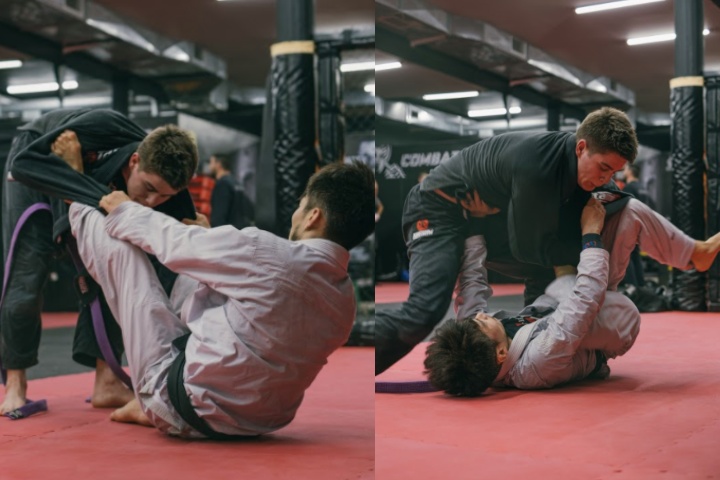One of the most elusive things that everyone who steps on the BJJ mats is looking for, even beyond their next stripe or belt promotion, is good cardio. Think back to the first time you took a BJJ class. The classic jiu jitsu class is usually made up of anywhere from a 10-20 (or longer) minute warm up, some technique and drill practice and usually wraps up with some live rounds of sparring.
Having traveled and trained at a wide of schools, the warm up has varied anywhere from light stretching on the easy end, all the way to 30 minutes of intense cardio, starting with running, calisthenics, animal-like body movements (akin to ginastica natural) and judo throw entries. Every other warm up has fallen somewhere within that spectrum.
The purpose of the warm up is to prepare the body and warm the muscles to prevent injury. Some instructors also like to fatigue the muscles and tax the cardio of their students to put them in a place where they are less likely to over-utilize strength during the technique portion.
The technique portion of a standard class is usually 2-3 positions with about 10-15 repetitions, depending on the allotted time the instructor gives you between techniques. During this part of the class, the focus should be on proper execution of the techniques against a non-resistant partner.
The average BJJ class usually ends with at least a short period of live training at the end where training partners spar and put their techniques to the test. This open ended portion of the class is sometimes considered optional, with a student rolling or not rolling as they’d like.
One of the most common statements heard on the BJJ mats, is “I need to improve my cardio.” Having solid cardio can improve every aspect of your BJJ game. Many people think they need to do hours and hours of cardio exercises outside of BJJ to improve their grappling. The truth is, you can improve your cardio without any extra work outside of your normal jiu jitsu training schedule. You simply have to have a plan. Let’s take a look at some ways you can achieve better cardio.
Don’t skip the warmup.
To achieve the most benefit out of class time and make the best gains in your cardio, you simply cannot skip the BJJ warm up. Let me repeat this. You. Cannot. SKIP. The. Warm up. Your goal should be to be winded, out of breath and fatigued. Your heart should be racing, you should be sweating and you should be gasping for breath. The typical BJJ match features periods of intense effort, followed by periods where there seems to be almost no energy being expended. This mix and fluctuation of aerobic and anaerobic expenditures is what makes BJJ so great as a physical exercise, but those periods tax your system and if you are not managing your energy properly.
By attempting to tax yourself in the warm up, you are creating a high level of aerobic and anaerobic expenditure which forces your body to ramp up the RPMs and recover in a safe environment when you’re not yet rolling. Let’s say you normally go through the motions during the warm up, the next time you step on the mats, say to yourself “I’m going to take up the intensity 50% during the warm up.” Run around the mats a little quicker, do your hip escapes with better technique and do some extra. If your class warms up with burpees, first off, I’m sorry. Secondly, don’t rush through them. Do them as perfectly as you can and complete as many as you can in the allotted time.
This process of trying to squeeze more out of the warm up can greatly improve your overall cardio, without adding any extra time to your training schedule. If you’re working to get into better shape, it can also allow you burn extra calories and move you closer to that goal as well.
Speed drills.
By now you’re sweating, your heart is racing and you’re trying to catch your breath as the class moves into the technique portion of the instructor’s game plan. Now is the time when the instructor shows a position or a technique and the students partner up and take turns doing 2 or 3 reps each until it’s time to circle back up and look at the next step in the lesson plan.
Though this is usually the least taxing portion of the class, it is still possible to keep your cardio ramped up and tax your system to keep the gains coming. When you and your partner move over to your little corner of the mats, it can be game on. It is important to let your training partner know what you’re trying to do. Once they are on board, your goal is to take turns performing AS MANY perfect reps as you can. So let’s say during a normal period of practicing, you get 8-10 reps. To increase the intensity, try to double that number and move quickly back and forth between you and your partner.
This still might not be as taxing as the warm up, but the increased intensity will tax your aerobic capacity and keep your heart rate elevated where it might normally settle down closer to a resting rate. Again, you are taking the standard period of class and trying to squeeze more intensity out of it.
1,2,3 Go.
By now you’re probably drenched and maybe ready to be done for the day, but this is where the true cardio benefit comes into play, during live rolling. Take a moment reading this to think about your standard roll. Chances are, depending on who you’re rolling with, out of a typical 5 or 6 minute round, you are probably ‘working’ during half of that if you’re lucky.
Try this technique during your next roll. No matter what position you find yourself in, whether good, bad or somewhere in between, do not stay in any one position for more than the count of three. Let’s say you’re a bigger grappler, with less than stellar cardio. Do you find periods where you can relax and catch your breath before you proceed? Maybe it’s side control, maybe it’s the mount, or maybe you’re on the bottom, rolling with a less experienced grappler and so you feel safe and in no real rush, with no urgency to get out. Instead of going through the motions of rolling, MOVE, advance, change position, ESCAPE, whatever it takes to never stop for the entire round.
No matter what belt level, size, or gender of your training partner, you can destroy your own cardio with some slight modifications. Use no strength, just go, and never stop for more than the count of three.
Be the last one rolling.
Maybe normally at the end of class, you roll for 2-3 matches, socializing a bit in between and then you head out for the night feeling accomplished. The goal of these tips is for you to maximize your training time. The goal of this article is to make sure you don’t need to do endless cardio outside of BJJ. Socializing with the jiu jitsu family is an amazing element, but don’t overdo it. Maybe you trim it down and in the same amount of time you normally spend live training, you add an extra 2-3 matches.
If you truly want to test yourself, set a goal at least one class a week, to be one of, if not the last person rolling. There are very few feelings better than knowing that you left every single thing on the mats that evening. Be smart. This might not be the way to handle every class (unless perhaps you’re getting ready for a competition). Consult with your coach and instructor. Let them know your goals and they’ll share their own experiences.
If your goal is to improve your cardio, realize you don’t need to spend endless hours on the treadmill or elliptical. There is nothing wrong with supplemental exercise and training, but jiu jitsu is a martial art and sport built on the fundamental principle of efficiency. Are you maximizing the amount of time you are currently training? By building in extra intensity into the classes that you take, you will improve your cardio, your fitness, and possibly lose extra unwanted weight if you manage your diet properly. Take advantage of the time you’re already spending and build more cardio without spending time you may not have.

















